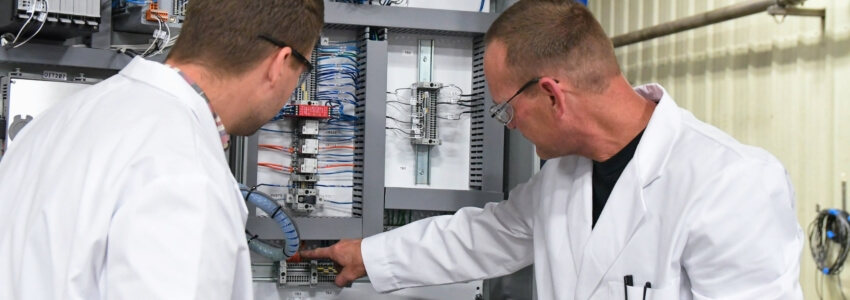Factory Acceptance Testing (FAT) and Site Acceptance Testing (SAT) are essential when it comes to ensuring that your equipment was built to last. The FAT will help you visually guarantee your equipment meets the specifications of the purchase order (P.O.), or contract. With Covid-19 concerns, the onsite visits have become more of a challenge, but not impossible. Following safety protocols recommended by the CDC for in person visits is the best way to keep your team and your equipment partners safe. Paul Mueller Company hosts have been trained and are continually updated on CDC guidelines and will take necessary steps in order to provide the safest environment for all parties.
Next, these 10 steps of successful testing will ensure the reliability of the product and provide necessary performance and operational function testing to make sure the equipment performs as designed and expected.
Keys to Successful and Efficient Testing
1. Keep your FAT date
It is important for both the manufacturer and customer to maintain a stable FAT date. Changes in time frame can cause various problems with staffing schedules and preparedness. Let the other party know as soon as possible if the date needs to be changed.
2. A good FAT begins before it starts
Good vendors will make sure the equipment is tested prior to your arrival. Pre-testing can happen anytime from weeks to days before the FAT. Your manufacturing partner should perform a pre-FAT test in addition to running a full capacity test or Production Data Report (PDR). The PDR will test the unit’s capabilities and flow rates to ensure the equipment produces what it is expected to produce.
3. Be aware of the testing procedure
Have a testing plan in mind to expedite the testing process and ensure safety for all personnel. Determine who will provide the test plan. A detailed plan will outline the quality, reliability, and safety requirements for your process. If possible, review the FAT documents prior to the FAT so you know what to expect. Standard testing includes functional and safety testing, such as alarms and warnings, but there may be additional customer-specific testing. Incorporating this into the FAT documents in advance will greatly reduce the testing time.
4. Involve the right personnel
This is the time to interact with the craftsmen and craftswomen who worked on all aspects of your equipment. Use their knowledge to your benefit. Recognize the different specifications of your equipment and become familiar with them at the FAT in order to be prepared when you have it fully set up at your operation. In other words, ask questions.
5. Assess risks and predict problems
List any anticipated shortcomings for the machine you are testing. These could include past issues experienced as well as expected outcomes for each phase of the process. Make a list of solutions for these potential problems to quickly and seamlessly work through issues during the testing process. Running, even dry running, is very critical. Making changes to equipment during the FAT stage is much more cost-effective and efficient than making on-site modifications.
6. Carefully check the safety features
When dealing with new equipment at an unfamiliar site, safety should be a top priority. Approach uncertain items and procedures with caution and, when in doubt, ask manufacturing technicians questions or pause testing to make sure the procedures are performed safely. Inspect your equipment with safe, reliable production or processing in mind. The test plan should check the functionality of all safety components and emergency switches and look for areas that may cause later problems or put a worker in a dangerous position. You should have an understanding of how the equipment will be utilized at your specific workplace.
7. Make the best use of the time available
Ask your manufacturer partner to have hook ups ready to go before starting. If they can also layout whatever equipment is needed for the next round of tests, the process will be much more productive.
8. Take your time
While the goal should always be efficiency, this concept includes more than just timeliness. Make sure that each stage of the test is carried out systematically, and that nothing is skipped or glanced over. Never cut corners with factory testing to meet a deadline. You will ultimately pay the price for this in longer start-ups and lost productivity at the factory.
9. Be flexible
Be prepared to change course during the FAT if problems arise. Be prepared to come in early or stay late to get the job done and expect your manufacturer partners to do the same.
10. FAT and SAT both exist for a reason
The purpose of the Site Acceptance Test (SAT), when the equipment has made it to your facility, is to determine how the machine works under the intended factory conditions. The manufacturer’s plant may not be equipped to test the machine at full capacity or with all product components included. Factory Acceptance Testing (FAT) at the manufacturer’s facility, therefore, will determine a piece of equipment can operate at the desired capacity without actually testing it at full capacity. Testing equipment for full-capacity production is reserved for SAT. It is best if all utilities are installed and ready for use. By placing a load on the equipment, it may be tuned and adjusted to respond to all on-site conditions, as needed.
FAT testing is intended to provide you with a thorough understanding of how your new equipment operates. Be sure to include equipment operators and maintenance personnel in the SAT procedure, so they may become familiar with the training. Additional on-site training may also be scheduled if it is not possible for everyone to attend the SAT.
Successful equipment projects come down to proper planning. Get your next project started off on the right foot. Click here to learn to how.


